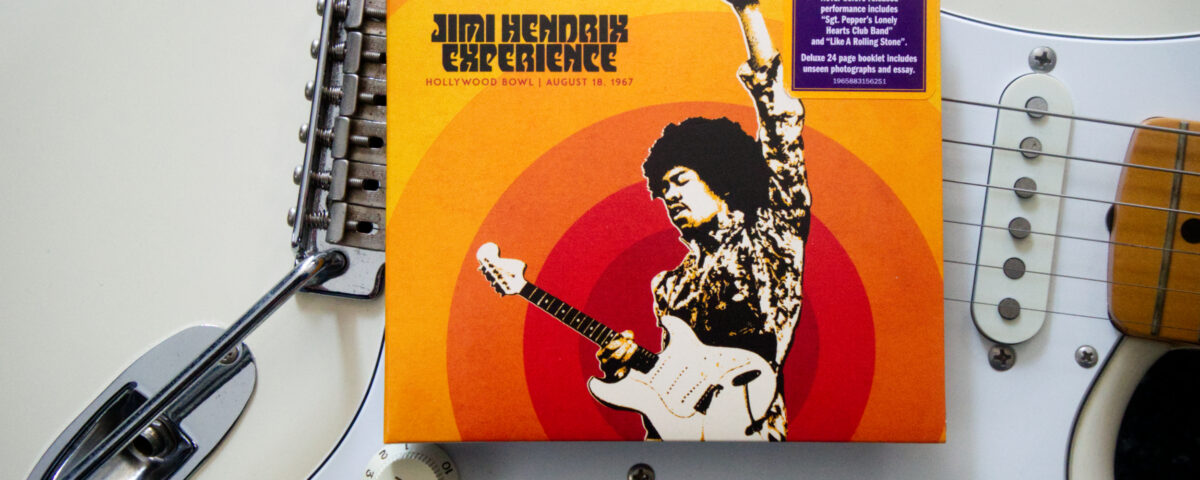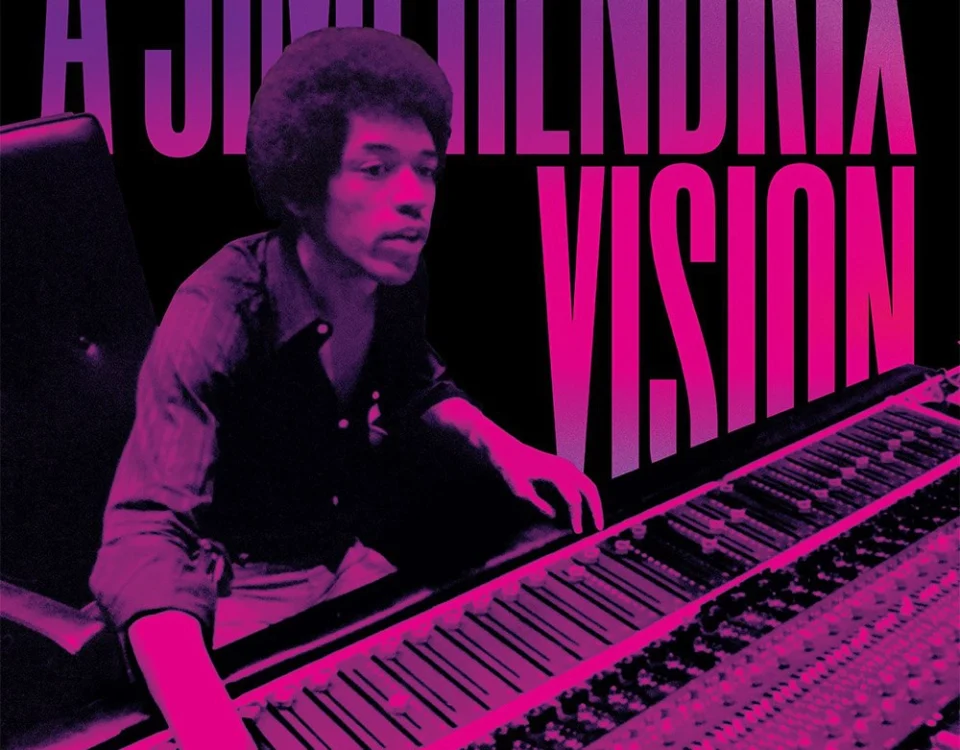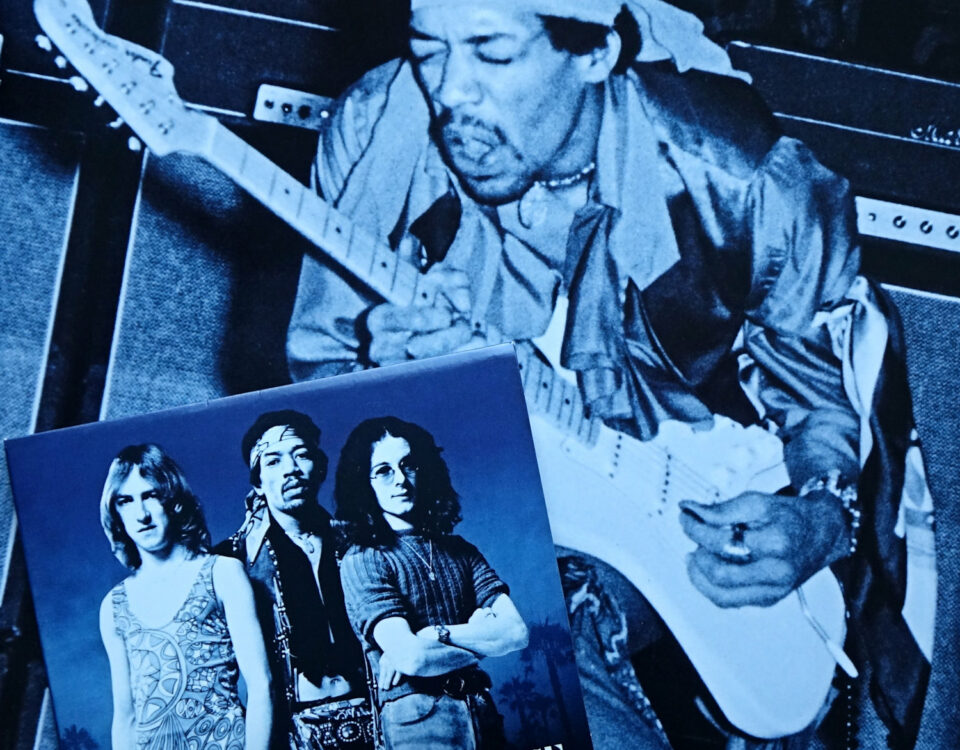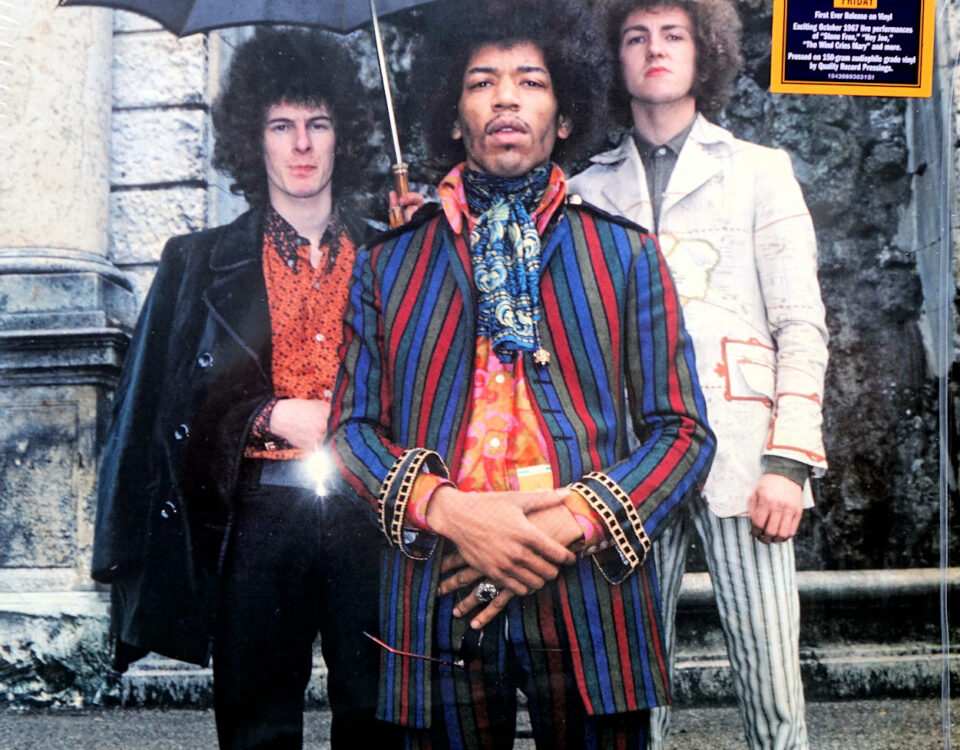CHAPTER TWENTY-SEVEN: CALIFORNIA DREAMIN’

The amount of music created by Jimi Hendrix that is in the hands (and ears) of dedicated collectors far outweighs the amount of Hendrix music that has ever been officially released. That means that usually, when the powers that be announce a new commercial release of “unheard” Hendrix music, in actual fact collectors have heard this material for many years and are merely hoping to get an upgrade in sound quality.
So, when Experience Hendrix announced the release of Jimi Hendrix Experience: Hollywood Bowl – August 18, 1967, the news set off seismic shock waves reverberating through the Hendrix community. Even the most jaded of collectors had to admit that, for once, this truly was something unheard, an Experience show that had never leaked out into the world at large since it was recorded more than five decades earlier.
Quite naturally (as Jimi would say), this new collection – along with two more familiar new releases – demands the next free chapter of Modern Listener Guide: Jimi Hendrix.
As always, keep in mind that these free online chapters of Modern Listener Guide: Jimi Hendrix are much more conversational and looser in format than the nearly 150,000 words in the published work, a massive effort detailing every major release by Jimi Hendrix up to the 50th anniversary Electric Ladyland box set (which was then covered in the first free chapter found here online). I spent five years working on the book, and you can read a free sample chapter of the published content here:
https://www.modernlistenerpublishing.com/inside-the-book/
It was a project well worth the effort, with (happily) book reviewers and (more importantly) purchasers agreeing, and I would be grateful for your support should you decide to order a copy! And so, on with the shows…
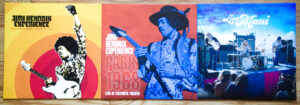
Our lineup for late 2023: one sonic discovery, two recyclings…
In the mid-summer of 1967, the Jimi Hendrix Experience were slightly adrift as far as a next move. The band had made its splashy United States debut on the final night of the Monterey International Pop Festival in June. But then co-manager Mike Jeffery booked the group into a high-profile but ill-advised commitment: as opening act for the sensation of the summer, the Monkees, stars of their very own television series. Though the band members got along famously, musically there was a distinct clash, the clamor and clang of the Experience not meshing with the pop-oriented sounds of the headliners. After seven shows, an evacuation from the remaining tour dates was arranged in mid- July.
(A personal side note: had the stars aligned with Jimi, Noel, and Mitch remaining on the road with their new pals in the Monkees, your then-eleven-year-old author would have seen the Jimi Hendrix Experience play with the Monkees in Memphis, Tennessee, on August 17. Ironically, the very next concert the young me would see was to be none other than the Jimi Hendrix Experience. Full circle.)
With their schedule now wide open, the Experience marked time in New York with club gigs, before the band hit the road with shows in Washington DC and Ann Arbor, Michigan. The band continued west, reaching California in mid-August.
John Phillips, along with his bandmate in the Mamas & the Papas Michelle Phillips, had been a driving force in the creation of the Monterey festival. And although Michelle had witnessed the Experience set that June night with a mixture of shock and horror (though she soon came around to adore Jimi personally), an invitation was extended to the Hendrix camp to open for the Mamas & the Papas at the Hollywood Bowl on August 18. It was to be a prestigious event, at a legendary venue appearing before a chart-topping act’s headlining set.
And so, with a recording machine surreptitiously documenting the event, Jimi Hendrix, Noel Redding, and Mitch Mitchell stepped onto the huge stage of the Hollywood Bowl.
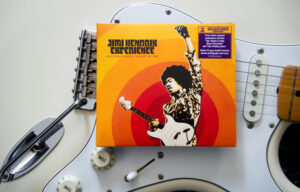
The striking cover art of the CD version of Jimi Hendrix Experience: Hollywood Bowl – August 18, 1967. The package is attractive, although the Stratocaster is not included!
Upon introduction, the Jimi Hendrix Experience receives something of an underwhelming reception. Jimi steps to the mic and requests that the multitude please “laugh in key,” a greeting that would more commonly refer to boos in the future.
As the Experience launch into “Sgt. Pepper’s Lonely Hearts Club Band” it is quickly apparent that the audio quality of this set is certainly acceptable. I had been listening earlier to The Doors’ new box set of The Matrix club recordings, and this Experience recording certainly outdoes that collection sound-wise. It is not pristine – the vocals are slightly overdriven – but the musical performance is all there. It’s easy to enjoy the sound of Mitch Mitchell driving the trio through their second song, a cover of Howlin’ Wolf’s “Killing Floor,” with the drummer locked in on Noel Redding’s bass as Jimi surfs over his charged rhythm section.
After two opening cover songs, “The Wind Cries Mary” is the show’s first Hendrix original composition, introduced with a brief tuning interlude. Uncharacteristically for this song, Jimi flubs the lyrics, taking a moment mid-song to figure out how to regroup. Musically the performance is more successful, but Jimi seems relieved to up the energy when the group moves on to “Foxy Lady.” It is a compact rendition, Jimi sticking close to the sonic diagram of the then-recently-recorded studio version.
In fact, that is the case with all the original Hendrix compositions played this evening, something no doubt reinforced by the Experience’s opening act status. Stretching out at length musically was likely discouraged in no uncertain terms. The closest the group comes to that territory is with the next selection, “Catfish Blues,” a song with cloudy compositional origins but tonight given credit by Jimi to Muddy Waters. Briefly claiming a chance to collectively spread their wings a bit, the Experience settle into the slow-blues introduction. Jimi boldly devises a short semi-abstract passage halfway through the song before the guitarist beats a hasty retreat to the lyrics. It sets up a thrashing Mitchell solo, the drummer’s sticks rolling across his kit in impressive fashion as he claims the evening’s longest time in the spotlight. Jimi returns to action, offering a wah-wah driven workout that sets up the headlong charge to the song’s finale.
Noel announces “Fire” as a request from the audience, although most of the crowd was likely still arriving for the concert and were getting their first introduction to the Jimi Hendrix Experience while hunting for their seats. Regardless, the song is taken at warp speed, Jimi machine-gunning through the verses.
Mitch likely needed to catch his breath after the sprint through “Fire,” and a Monterey-like cover of Dylan’s “Like a Rolling Stone” provides a respite – although this time, Jimi does not miss the third verse as he’d done at the Experience’s festival debut up the California coast several weeks earlier (“Yes, I know I missed a verse, don’t worry…”). Closing the track with a series of high, wailing notes, Hendrix slightly extends the song’s resolution.
“Purple Haze” follows the Dylan track, ramping up the energy again with a by-the-book rendition setting up the end of the show. After announcing his preference for drums and “feedback guitars” instead of weapons of war, Jimi turned to his interpretation of the Troggs’ “Wild Thing” as a chaotic closing punctuation for the band’s set. Frequently utilized as a concert finale in this early era of the Experience, “Wild Thing” allows Hendrix to unleash familiar monolithic chords while establishing a lumbering pace. The song begins to shed structure toward the end, arriving at what Noel usually described as “a freak-out” – no doubt accompanied by any number of Jimi’s showy gyrations and advanced physical guitar stunts.
With the set concluded, the cheers from the Hollywood Bowl audience do not exactly drown out the final droning note from Noel’s bass, but there is applause and no boos – so, the gig was surely considered a success.
Jimi Hendrix Experience: Hollywood Bowl – August 18, 1967 is available in both CD and vinyl formats, with a separate booklet containing often-seen photographs of the afternoon soundcheck as well as of the concert itself. Yet despite Jeff Slate’s liner notes breathlessly pumping up this show, ultimately what we have is a decent performance from the band’s first year. It is competent and entertaining, but certainly not as exciting or urgent as the Monterey Pop recording. And the towering musical achievements that are hallmarks of Jimi’s career still lay ahead.
So, in the end, the very idea of Jimi Hendrix music that had not been heard before proved a bit more promising than the actual content itself. You could argue this recording would have been better served as a release on the Experience Hendrix sub-label Dagger Records. Then again, would a lower-key official bootleg support the marketing of multiple Hollywood Bowl t-shirts and related paraphernalia that is now available for purchase through Experience Hendrix? The answer to that question is obvious.
Still, it was a true pleasure to encounter something entirely new from the realm of Jimi Hendrix, as Experience Hendrix have proven themselves to be masters at re-releasing titles and material over and over and over again.
Speaking of such recycling, let’s look at the other two releases we’re listening to for this virtual chapter of Modern Listener Guide: Jimi Hendrix. Those would be Jimi Hendrix Experience Paris 1968 Live at L’Olympia Theatre and Live in Maui, both in LP format only, pressed in heavyweight vinyl and packaged within simple sleeves with no booklets, their rear covers offering just a few paragraphs of notes to provide context.
Let’s start by winging our way across the ocean and through five months from Hollywood in August 1967 to arrive in Paris on January 29, 1968 for the Jimi Hendrix Experience Paris 1968 Live at L’Olympia Theatre.
Aside from the jet lag and time/space disorientation, do you have a sense of déjà vu? Well, that is certainly understandable, as the show recorded on this night is one that has been previously released under the unwieldy title Live in Paris & Ottawa 1968. That release is one of two in an occasionally confusing pair of Experience Hendrix releases teaming up performances captured in the unlikely civic tandem duo of Paris and Ottawa in both 1967 and 1968. Yet this specific Paris gig was in the public ear long before Experience Hendrix was even formed, as it was one of the four shows presented by the Stages box set of 1991, a live collection shepherded into existence by the late Alan Douglas.
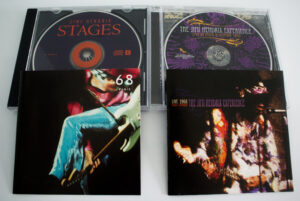
The first – and second – time around for the Paris January 1968 concert performed by the Jimi Hendrix Experience.
And yet, here we are in 2023 with the show now residing under its new title Jimi Hendrix Experience Paris 1968 Live at L’Olympia Theatre and available exclusively via purchases made through Amazon.
As there is nothing new to add about this show’s music, since it has been repeatedly released over the years, what I said about the concert in the published edition of Modern Listener Guide: Jimi Hendrix obviously applies to this Amazon-only product:
This Paris concert was the second of two shows on that late January day, and Jimi Hendrix announces his presence with a long, low feedback wave. He dips into a brief exploratory intro before leading the band into a loping, relaxed warm-up take on “Killing Floor,” crowned by a solo of long, metallic notes.
Still early in the set, the Experience uncharacteristically drop into low gear with “Catfish Blues,” which gives Mitch Mitchell his own chance to warm up on the drums. His impressive solo leads into an extended wah-wah passage by Jimi. This effect pedal was originally designed to do no more than mimic a trumpet player moving his mute on and off the bell end of his horn. But here Jimi is reinventing the effect, casting it through a spectrum that ranges from fuzzed-out cascades to clear, brittle squiggles.
With the blues fully established by “Catfish Blues,” the Experience turns its attention to rocking hard, the welcoming audience at the Olympia enjoying a lumbering and powerful “Foxy Lady” anchored by Noel’s nearly reggae-like bass approach.
Late in the performance, the lone song from the then-new Axis: Bold as Love album makes its appearance. The delicate introduction of “Little Wing” quickly hushes the raucous crowd. The beauty of the song is unquestionable, matching the studio version nearly note-for-note until Hendrix subtly improvises his way through the outro solo.
“Purple Haze” closes the show, brought to life with Jimi flicking his Stratocaster’s pickup selector switch while simultaneously violently working the tremolo bar. The chorus of unearthly sounds is abetted by a favorite Hendrix modification made to his Stratocaster: the removal of the plastic plate covering the tremolo springs on the back of his guitar’s body. This provided access so Hendrix could strike and scrape those springs at will. This contact, when highly amplified, “makes these weird little sounds,” as Jimi described the practice. In truth, it all sounded anything but “little,” Hendrix’s bag of tricks yielding ping-ponging sheets of massive sound.
Whatever made Experience Hendrix feel the urgent need to take the bulk of the content from their own 2008 CD Live in Paris & Ottawa 1968 and issue it on vinyl exclusive to Amazon we’ll likely never know, but here it is nevertheless.
However, Amazon is not the only mega retailer to land a Jimi Hendrix exclusive release late this year. Yes, Walmart has entered the fray with an exclusive and attractive turquoise single LP variation of Live in Maui, extracting its content from the heavyweight Maui box set released back in 2021. You will find all the details you need about that must-have collection in the free Modern Listener Guide: Jimi Hendrix chapter titled Chapter Twenty-Four: Man vs. Volcano – Jimi on Maui. Just follow this link:
https://www.modernlistenerpublishing.com/chapter-24-man-vs-volcano-jimi-on-maui/
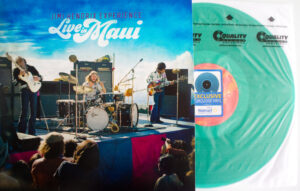
Live in Maui now pressed in turquoise, a color most famous for being namechecked in Jimi’s lyrics to “Bold as Love.”
As a two-sided vinyl standalone subset of the parent release – which sprawled across six sides of vinyl – this Cliff Notes edition is quite enjoyable, striking a nice balance between material Jimi had been working on at the time of the Maui show in the summer of 1970 and the tried-and-true concert stage workhorses. “Hey Baby (New Rising Sun),” “In From the Storm,” “Foxy Lady” (as usual for Experience Hendrix, spelled “Foxey”), and “Ezy Ryder” make up an energetic first side. On the flip side, Jimi stretches out on “Hear My Train A-Comin’” and “Voodoo Child (Slight Return)” before things wrap up with “Purple Haze.” Everything on this new album save two songs comes from the vinyl box set’s first record.
It is interesting to compare the versions of two of Jimi’s biggest hits – “Foxy Lady” and “Purple Haze” – that appear on both Hollywood Bowl and Maui. On the live album recorded in Hollywood in 1967 Jimi conservatively replicates the studio versions of these songs as heard on the American edition of Are You Experienced and on singles pressed in in the UK. Three years later in Hawaii, though, Jimi is far more interpretative with his renditions, particularly in the astonishing riffs and improvisations he seemingly effortlessly tosses in between the lines of the song’s verses. The adventurous nature of Jimi’s musical explorations shines through to staggering effect.
This Live in Maui variation is not essential, although, of course, the box set from which it is extracted certainly is. But it is a pleasant little curio nonetheless, something to help pass the time while we all wait apparently forever for the release of the Royal Albert Hall material. Coming on the thirteenth of anytime?
Until then, we are left wondering if there is further unheard material lurking in the Experience Hendrix vaults. If so, the question becomes: why is so much ongoing effort dedicated to rereleases of material that entered the commercial market years earlier? The answer to that we may never know!
